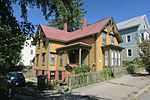Roger Mowry Tavern

The Roger Mowry Tavern, also known variously as the Roger Mowry House, Olney House and Abbott House, was a historic stone ender house, built around 1653, in Providence, Rhode Island. Roger Mowry was a constable and operated the only tavern in the town. The tavern also served as a government meeting place, church, and jail. It was originally constructed as a 1+1⁄2-story single room house with a chamber upstairs. By 1711 the house was expanded with a two-story lean-to by 1711. At unknown later date, the top of the roof of the original house was raised up further. The original portion of the house was restored by Norman Isham by 1895. The Roger Mowry Tavern was the oldest house in Providence until it was demolished in 1900.
Excerpt from the Wikipedia article Roger Mowry Tavern (License: CC BY-SA 3.0, Authors, Images).Roger Mowry Tavern
Abbott Street, Providence
Geographical coordinates (GPS) Address Nearby Places Show on map
Geographical coordinates (GPS)
| Latitude | Longitude |
|---|---|
| N 41.8427 ° | E -71.4072 ° |
Address
Abbott Street 4
02906 Providence
Rhode Island, United States
Open on Google Maps











